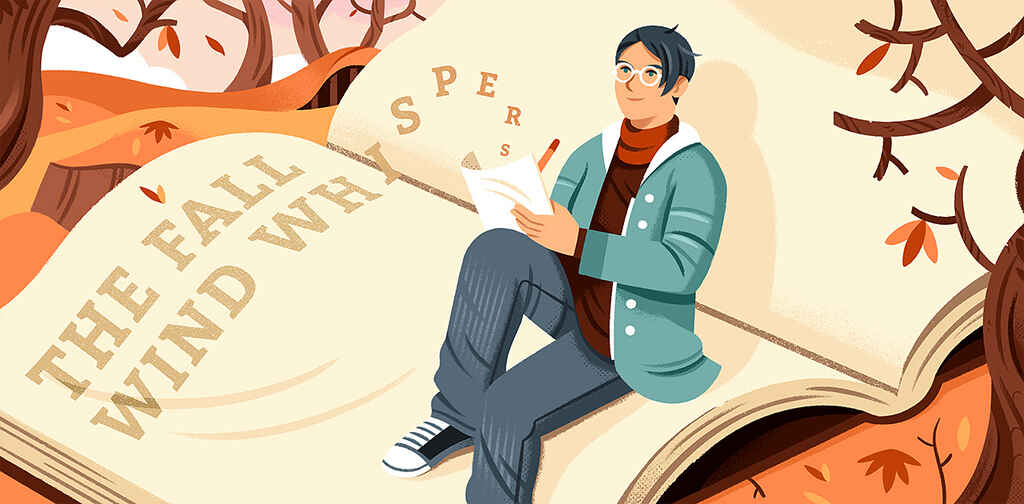Guides • Understanding Publishing
Last updated on May 30, 2023
How to Publish a Short Story: 3 Ways to Reach New Readers
About the author
Reedsy's editorial team is a diverse group of industry experts devoted to helping authors write and publish beautiful books.
More about the Reedsy Editorial Team →Savannah Cordova
Savannah is a senior editor with Reedsy and a published writer whose work has appeared on Slate, Kirkus, and BookTrib. Her short fiction has appeared in the Owl Canyon Press anthology, "No Bars and a Dead Battery".
View profile →Once you've gotten the hang of the short story medium, and how to write short stories, the next stage is to get them in front of readers — preferably ones who will appreciate your writing. In this post, we'll walk you through the most popular ways of getting a short story out into the world.
Three ways to publish a short story:
1. Submit them to literary magazines
Literary magazines are the traditional home of short stories, where many writers first get their works showcased to an audience beyond their family and friends. Magazine publication is a tried and true method for getting eyes on your work and gaining followers (plus earning a small chunk of money along the way).
There are hundreds of magazines out there, ranging from the prestigious to the niche, so no matter what you’re writing, there will be a place for it. Luckily, it’s easy to submit a story, and you can break down the process into three simple steps.
Seek out suitable magazines
If you’re not an avid reader of literary magazines and already writing with a certain publication in mind, a great place to start is Reedsy’s literary magazine directory. This handy resource does the hard work for you, listing hundreds upon hundreds of magazines. You can filter by the genre you’re writing in, whether they require a submission fee, the format they publish in, and much more.
As you discover new magazines, consider where your story fits best. Some factors to consider include:
🎭 Genre and topic. If you've written a historical romance, don't include a sci-fi publication in your submission list.
📝 Short story length and style. Some magazines look for flash fiction (under 1,000 words); some ask for 5,000 words per piece. Most lie somewhere in between. Publications sometimes also ask for specific writing styles, like epistolary, or set themes for the stories.
✅ Author requirements. Most magazines and competitions are open to international submissions from anyone at least 18 years old, but some might have other conditions.
🔄 Simultaneous submissions. Do you want to submit to several places at once? Not every magazine will accept this, and contests definitely don't.
📚 Multiple submissions. If you have more than one story on hand, you may want to submit a few at a time, although not every magazine will accept that either.
Make sure to double-check each magazine’s submission guidelines. This is usually located on the submissions page of their website and outlines any specific restrictions or wants the magazine may have, like the preferred font and spacing for your manuscript.
Be aware that some magazines will have specific submission windows or reading periods when they are open to receiving new stories. Sometimes, you’ll need to wait a little bit until their window opens again to submit your work to the perfect magazine.
Even once you’ve selected your targets, the work isn’t done yet — you’ll need to prepare your supporting material for your submission.
Make an impression with your cover letter
 A literary magazine's editors (or, more likely, editorial assistants) may be reading hundreds of entries for each issue, so anything you can do to make yourself stick in their memory is good — and that starts with the cover letter. It doesn’t need to be anything fancy: keep it short and sweet, but pack it with information.
A literary magazine's editors (or, more likely, editorial assistants) may be reading hundreds of entries for each issue, so anything you can do to make yourself stick in their memory is good — and that starts with the cover letter. It doesn’t need to be anything fancy: keep it short and sweet, but pack it with information.
Most magazines these days will have a digital submissions form, which usually includes a field for your cover letter.
To start, quickly introduce the story you’re submitting and its word count. You can talk about what inspired the story or give its basic premise here, but keep it short — a sentence or less is ideal. Then, move on to introducing yourself.
Essentially, this is your author bio: the place for you to show off any credentials you have (or experience that ties into your submission). This could include other magazines you’ve been published in, any books you’ve written and published, any awards or accolades you’ve received, or anything else that showcases your writerly abilities.
Don’t worry if you don’t have any publishing credits to your name, though. Literary magazines are more than willing to take a chance on unknown authors and have long been the place where writers launch their careers.
To make your cover letter more personal, you should directly address the editors in your greeting and mention any recent stories from the magazine you’ve enjoyed. This shows you’ve done your research and have a good sense of what will fit in the publication — aka, your own story!
Your cover letter could look something like this:
Dear [Editor’s First and Last Name],
Please consider [Story Title], a [word count] [Genre] short story, for publication in your magazine. I am an emerging writer; if this story gets accepted, it will be my first published work.
This story is being submitted to several publications, and I will let you know if I hear back from other places.
I am finishing my MA in Creative Writing at [University Name]. When I’m not writing, I usually work on my webcomic, experiment with watercolor painting, or go on hikes in the countryside with my partner.
Thank you for your time and consideration.
Sincerely,
[Your Name]
Once you send your story out for consideration, there's still one small step left.
Track your progress
If you’re sending your short story out to multiple magazines through different methods and platforms, it can be easy to lose track of where you’re at. Finding a way to keep this information organized will keep your stress levels low and keep you on top of your submissions.

You can set this up in a document or make notes by hand, but to save you time we have a handy little submissions tracker spreadsheet filled out and ready to go. Download it here!
FREE RESOURCE
Story Submissions Tracker
Stay organized on your journey to find the right home for your short stories.
It's a good way to see where your stories are, how long you want to keep waiting for a response, and where you can go next if your attempt was unsuccessful. Keep in mind that usually editors and judges take 8-12 weeks to get back to you, but this does vary from publication to publication, and their submission guidelines page may give more specific information.
If you don’t have a story ready to go or need some inspiration to get started, a writing contest might be up your alley.
Q: How can writing short fiction help aspiring novelists develop their writing skills?
Suggested answer
Short fiction and novels demand different approaches from the writer. While the former generally prizes brevity, delivery, and brief portraiture or still life, the novel favours plot, abundant detail, and characterization – in other words, the novel involves some level of world building that short fiction simply cannot accomplish. Perhaps this helps explain why writers like Toni Morrison and Cormac McCarthy stuck to writing novels but only ever published one short story each, while a writer like Alice Munro only ever wrote short fiction. Her southern Ontario setting that occupied so much of her fiction was not established through a single work but instead over multiple.
The question remains then: why should an aspiring novelist try writing short fiction if it requires a different approach (if not different skills)? For starters, regardless of your preferred mode, writing requires practice but sometimes the breadth and complexity of a novel is not the right format to stretch your writing muscles. Whether you intend to publish or not, short fiction can be the ideal experimental space for testing voice, style, themes, and settings in a way that provides a fresh perspective not only on the stories you wish to tell but on the language with which you aim to tell it. Short fiction's shorter word count can give an aspiring novelist a healthy appreciation of pace and brevity; viewing language as a finite resource forces you to pay attention to the finer details that constitute a “good” sentence or paragraph.
When I taught Creative Writing at York University, we did short writing activities like object description or still life that asked students to create a scene bereft of motion or dialogue (and in some cases, bereft of character as well). Rather than being concerned with the movement or trajectory of the plot, students were required to pause, take a breath, and see what they could produce in an imagined space where there was no action. What details emerged? What drew your eye? What language did you favour? These writing activities were meant to show students what they could accomplish in the space of a few hundred words, but it’s a perspective that I think aspiring novelists can also learn from. It can help writers gain control over their narrator’s wandering eye or demonstrate just how much can be written about a scene where nothing happens. These kinds of so-called “plotless” scenes or perspectives can help the novelist structure and balance a narrative arc, for example, or help them to appreciate the kind of world their characters exist in.
In summary, short fiction involves writing with restriction. While the aspiring novelist might find it more liberating to write without a self-imposed word count, it is precisely through short fiction that writers can come to appreciate important components for writing well that can transform a good novel into a great one.
Mitchell is available to hire on Reedsy ⏺
2. Take part in writing contests
 Writing contests are similar to literary magazines in that they solicit submissions directly from writers — and many literary magazines host contests alongside their regular submissions — but they also offer the prestige of being a prize winner, and the satisfaction of having your work recognized by a panel of judges.
Writing contests are similar to literary magazines in that they solicit submissions directly from writers — and many literary magazines host contests alongside their regular submissions — but they also offer the prestige of being a prize winner, and the satisfaction of having your work recognized by a panel of judges.
Contests might also offer added bonuses, like getting a blurb or introduction from a judge or getting a review by a literary agency, among other things. It can be a great place to gain some recognition since your success in a contest really is measured by your writing, not who you know or previous publication. All the judges care about is that you have a good story and tell it well. There are many writing contests out there — all you have to do is find them.
Search for contests
There are just as many writing contests out there as literary magazines and they provide a great opportunity for beginning writers to build practice and credibility. And get published, of course! Along with a cash prize, winning a contest often means you’ll be published in an organization’s own magazine or website, or in an anthology alongside other winners or shortlisted stories.
Some contests that publish anthologies are the Desperate Literature Short Fiction Prize, the BBC National Short Story Award, and the Bath Short Story Award.
Publishers, writer’s guilds, and other literary organizations often host contests, so if there are any in your area, see if they have a contest you can enter. Otherwise, Google is your best friend. But always be on the lookout for any scams. If it looks too good to be true, it probably is.
💡 Want to know how to spot publishing scams? Check out this guide for tips on what they look like & how to avoid them.
If you want to avoid scams and take some of the research time out of your browsing, Reedsy’s writing contests directory has over 500 verified, up-to-date contests you can enter today.
Try out prompts-based contests
Instead of a traditional writing contest, why not try a prompts-based contest? Take inspiration from a prompt rather than racking your brain for an idea. The challenge of fitting a story to a specific topic while still remaining unique among dozens of other entries is a great writing exercise. And posting it on a community forum will give your writing exposure, perhaps gaining new fans who want to see more of your work.
If that interests you, Reedsy has its own Prompts contest you can enter. You can choose from one of five prompts every week and create a story based on them. It’s just five dollars to enter, and if you win, there’s a chance you could be published in Prompted, Reedsy’s very own literary magazine.
3. Self-publish a short story anthology
In many ways, self-publishing has completely changed the landscape of traditional publishing, and that applies even to the realm of short stories. If you’d rather not wait for your work to be accepted by a literary magazine or win a writing contest, you can take the power into your own hands by self-publishing an anthology of your short stories instead. To ensure that you have a satisfying and cohesive book that readers can discover and fall in love with, check out these three tips.
Note: The information below isn’t an exhaustive how-to list, but some important points to remember. If you’d like more detailed information about self-publishing, check out our in-depth guide here!
Pick an overarching theme for your anthology

One of the biggest pros of publishing your own anthology is you aren’t limited by the requirements of an outside organization, whether that pertains to topic or word count. The world is your oyster, and you can stretch your imagination's limits. However, the best anthologies aren’t simply a collection of an author’s work, but in some way, form a cohesive whole.
The easiest way to do this is by giving your anthology a central theme. Your stories could explore an idea from different angles or all be set in the same place. This connection doesn’t need to be obvious. In fact, it can be relatively loose, so long as when you put everything together, no story feels like the odd one out.
For example, The Secret Lives of Church Ladies by Deesha Philyaw explores the stories of Black women and girls whose lives are caught in a bind between the wants of the church and their own desires. While every story has this overarching theme, Philyaw discusses wide-ranging ideas from sexuality to generational trauma in each tale, and no two stories are exactly alike.
If you need some inspiration, check out published short story anthologies to see how other authors have done it. Or you could hire a developmental editor to look over your collection and help you streamline it.
With the content down, you still have to consider how your collection physically looks.
Make sure your book looks professional
When you’re self-publishing, you need to consider much more than just the writing of your book. Another important job is ensuring that your book is properly formatted. It will make your anthology look more professional and overall make for a better reading experience.
Even if you have no design knowledge, there are plenty of free easy-to-use tools that can help. We might be biased, but we recommend the Reedsy Book Editor. It’s a free book formatting app that is full of useful features. You can insert page breaks, style your paragraph and chapter titles, create a table of contents, and much more. Once you’ve finished working on the interior, you can export ebooks or print files that you can then import to your printing service of choice.

FREE FORMATTING APP
Reedsy Studio
Format your manuscript for print or EPUB with a single click.
To make your book look even more professional, consider hiring a book cover designer to create a stunning cover and establish a visual brand that you can replicate for future anthologies. While the old adage advises us not to, readers really do judge a book by its cover, so having something that looks good and stands out will help you draw people in just as much as the rest of your marketing materials.
Now your book is ready to go. But as you prepare to officially launch it, consider what you can do to market it.
Start building your author platform
As an independent author, getting the word out about your book is incredibly important. You are your own marketing team, and there are many things you can do to support your book, from sending out ARCs to setting up Amazon ads. One thing you should definitely be focusing on is building a following; it creates longevity and a dedicated reader base who can help you promote your book in the future.
Capturing your readers onto your newsletter or on social media will allow you to nurture your readership and stay connected with them. It’ll also be helpful in the future as you now have a ready audience to whom you can market any future anthologies (or even novels if you decide to go long-form later).
You can do this by having a link to your socials and mailing list at the end of your book — and maybe entice readers further by offering a free bonus story when they sign up!
For a more in-depth look at how to create an author platform and market your book, download a free copy of Reedsy’s How to Market a Book, written by our co-founder Ricardo Fayet.
No matter which path you take, publishing a short story is a fantastic way to reach new readers and make a name for yourself in the literary world. There's an audience out there for your work, so take the leap and find them! To help you get started, we've compiled a list of places where you can submit your short stories.



